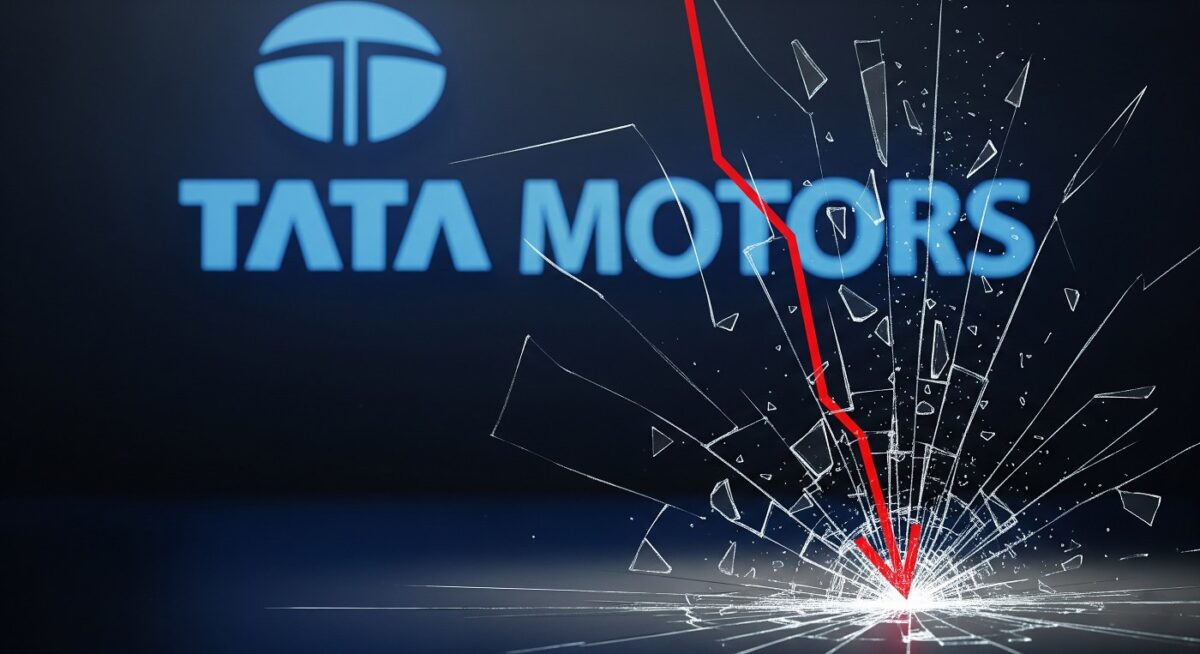The Indian stock market is no stranger to volatility, but the recent trajectory of Tata Motors (TATAMOTORS) shares has sent significant ripples through investor portfolios. Witnessing a staggering fall of approximately 45% from its recent peak, the stock of this automotive giant has become a focal point of concern and intense analysis. If you’re holding Tata Motors shares, considering an entry, or simply tracking the auto sector’s health, understanding the forces behind this dramatic plunge is crucial. This isn’t just a minor correction; it’s a significant market reassessment demanding a closer look.
Understanding the Investor Psyche: Why This Crash Matters
Before diving into the “why,” let’s consider the “who.” Readers searching for “Tata Motors shares crash” are likely:
- Existing Shareholders: Anxious about their investment’s value, seeking explanations and future outlook to decide whether to hold, average down, or exit.
- Potential Investors: Spotting a significant price drop, evaluating if this represents a compelling buying opportunity (“buying the dip”) or a value trap.
- Market Enthusiasts & Analysts: Tracking broader auto sector trends, macroeconomic impacts, and the health of a major Indian conglomerate.
- Retail Investors: Concerned about contagion effects or looking for lessons applicable to their broader portfolio strategy.
Their core questions are simple yet critical: “Why did this happen?”, “Is the worst over?”, and “What should I do now?” Addressing these requires peeling back the layers of Tata Motors’ recent struggles.
Dissecting the Downturn: Key Factors Behind the Crash
The decline isn’t attributable to a single event but a confluence of significant headwinds:
The Profitability Punch: Weak Quarterly Earnings Shock
The most immediate trigger was the stark revelation in the company’s Q1 FY25 results. Tata Motors reported a 63% year-on-year decline in consolidated net profit, plummeting to ₹3,924 crores from a robust ₹10,426 crores in the same quarter last year.
This wasn’t just a miss; it was a substantial underperformance. The reasons cited – soaring raw material costs, intense competitive pressures leading to margin erosion, and higher operating expenses – painted a picture of an operational environment becoming significantly tougher. For a stock trading at premium valuations based on growth expectations, this earnings miss was a major credibility blow.
The JLR Juggernaut Hits a Wall: Tariffs and Cash Flow Concerns
Jaguar Land Rover (JLR), Tata Motors’ prestigious but often volatile crown jewel and primary profit driver, delivered a double whammy of bad news.
The US Tariff Hammer: The imposition of steep 25% tariffs on certain imported Chinese EVs by the US government had an unexpected consequence. While targeting China, the tariffs also ensnared JLR’s popular Range Rover Evoque and Discovery Sport models manufactured in China. This forced Tata Motors to temporarily halt shipments of these crucial models to the vital US market, creating immediate revenue disruption and casting a long shadow over future export strategies reliant on Chinese production.
Cash Flow Headwinds: Adding to the anxiety, management projected lower free cash flows (FCF) for JLR in FY25, primarily due to anticipated higher investments and working capital needs. JLR’s strong FCF generation in recent quarters had been a key pillar supporting the parent company’s overall valuation and debt reduction plans. A forecasted reduction directly impacts investor confidence in near-term financial flexibility and shareholder returns.
Macroeconomic Maelstrom: The Bigger Picture Bites
Tata Motors doesn’t operate in a vacuum. Broader economic currents have been decidedly unfavourable:
Geopolitical Tensions & Trade Policy Uncertainty: Ongoing conflicts and the escalating trend of protectionism (exemplified by the US tariffs) create an environment of heightened uncertainty for global businesses like Tata Motors. Supply chain risks increase, and long-term planning becomes fraught with difficulty, dampening investor appetite for cyclical stocks.
Interest Rate Landscape: Persistently high interest rates globally increase borrowing costs for companies and consumers alike. This can dampen demand for big-ticket items like cars, especially premium models, and squeeze margins further.
Domestic Market Pressures: While the Indian passenger vehicle market shows resilience, competitive intensity is fiercer than ever. The transition to stricter emission norms (CAFE 3, RDE) also adds cost complexity.
Valuation Reckoning: High Expectations Meet Harsh Reality
Prior to the crash, Tata Motors stock, particularly buoyed by the JLR turnaround narrative and strong EV buzz, was trading at relatively rich valuations. The Q1 earnings miss and the JLR guidance acted as a cold shower, forcing a sharp market reassessment. Investors began questioning whether the previously anticipated growth trajectory and premium multiples were still justified in the face of these tangible operational and macro challenges. This repricing has been swift and severe.
Analyst Chorus: Cautious Notes Dominate
The analyst community, once largely bullish, has significantly tempered its outlook:
- Downgrades and Target Cuts: Several prominent brokerages have downgraded the stock or slashed their target prices post-Q1 results and JLR updates.
- Heightened Risk Perception: Analysts consistently highlight the increased risks: JLR’s exposure to tariff wars and geopolitical instability, the intensity of competition in both domestic and international markets, and the pressure on margins from rising costs.
- The ₹550 Question: Global brokerage firm Jefferies notably adopted a cautious stance, setting a price target as low as ₹550, implying significant further downside potential from current levels. While not all are this pessimistic, the direction of sentiment is clear – caution prevails.
- The Bull Case Fades (For Now): The counter-arguments – Tata Motors’ strong brand portfolio, leadership in India’s EV transition, and JLR’s underlying product strength – are still acknowledged but are currently overshadowed by the near-term headwinds. Analysts need tangible evidence of overcoming these challenges before reigniting strong bullish calls.
Beyond the Crash: What Lies Ahead for Tata Motors Shares?
Predicting the bottom is always perilous, but assessing the path forward involves monitoring key catalysts:
- JLR’s Navigation Skills: How effectively and swiftly can Tata Motors mitigate the US tariff impact? Can they shift production, secure exemptions, or absorb costs without crushing margins? Progress on resolving the shipment halt is critical. Achieving the revised (even if lower) FCF guidance will also be closely watched.
- Domestic Margin Recovery: Can the Indian operations (Passenger Vehicles and Commercial Vehicles) demonstrate sustained margin improvement despite cost pressures and competition? Success in the growing EV segment (where Tata leads) is vital, but profitability here is still evolving.
- Macroeconomic Tide: A softening of global interest rates, easing of trade tensions, or sustained strong domestic economic growth could provide tailwinds. Conversely, further escalation of any existing headwinds would prolong the pain.
- Execution is King: Delivering on operational efficiency targets, managing inventory well, and launching successful new models (especially EVs) will be essential to rebuild investor trust.
The Investor’s Compass: Navigating the Uncertainty
For those directly impacted or considering involvement:
- Existing Shareholders: Conduct a brutal honesty check. Does your original investment thesis (based on JLR’s strength, EV leadership, etc.) still hold water in light of the tariff issues and margin pressures? Are you prepared for potentially more volatility? Consider your risk tolerance and investment horizon. Averaging down is a high-risk strategy that requires strong conviction in a fundamental recovery.
- Potential Investors: Exercise extreme caution. While the price is significantly lower, the fundamental challenges are real and unresolved. Treat this as a high-risk, potentially high-reward opportunity only if you have a very strong, research-backed conviction in Tata Motors’ ability to overcome these specific headwinds relatively soon. Wait for concrete signs of stabilization or improvement (e.g., resolution on JLR shipments, sequential margin improvement) before committing capital. The current environment favors a “wait and see” approach for most.
- All Investors: Diversification remains paramount. Avoid overexposure to any single stock, especially one navigating such significant turbulence. Focus on long-term fundamentals over short-term price movements driven by sentiment.
Conclusion: More Than Just a Speed Bump
The 45% crash in Tata Motors shares is far more than a routine market correction. It’s a stark reflection of the complex interplay between company-specific missteps (the earnings miss), strategic vulnerabilities exposed (JLR’s tariff sensitivity), and a hostile macroeconomic climate. The premium valuation once enjoyed has evaporated as the market demands proof of resilience and adaptability.
Recovery is possible – Tata Motors possesses strong brands, a significant market share, and is pivotal to India’s auto future. However, the path back will likely be arduous. It requires deft navigation of trade policy hurdles, demonstrable margin recovery, and perhaps a touch of macroeconomic luck. For investors, the message is clear: tread carefully, prioritize research over reaction, and align any decisions regarding Tata Motors stock with a clear understanding of the heightened risks and the patience required for a potential turnaround. The road ahead for Tata Motors shares remains bumpy, demanding both vigilance and realistic expectations from those who choose to travel it.









